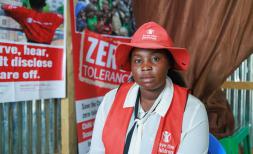Why adolescent nutrition must not be ignored

Cousins Anabely, 11, and Maria Elena, 12, eating fruit at school in Quiche district, Guatemala. Luisa Dörr / Save the Children.
“When I feel extremely hungry, I am afraid of dying. When I fall asleep, I am afraid that I may not wake up again because I am too weak.” Rova*, 17, Madagascar.
No child should ever have such fears. Yet, even in higher-income countries, adolescent wellbeing is often neglected.
Tackling adolescent nutrition provides an unparalleled opportunity to turn the tide on intergenerational malnutrition and build a healthier generation.
As adolescents, advocates and leaders come together this week at the Global Forum for Adolescents on the 11-12th October, we urge governments to increase investment in adolescent nutrition. This investment should support improved adolescent health today, their health and well-being in adulthood, and ensure the healthy growth and development of the next generation.
Good nutrition supports healthy futures.
Adolescence is a period of rapid growth and development, increased nutrient needs and a change in eating patterns. Yet nutritious foods are not always accessible to adolescents.
As they experience autonomy, their peers and social media increasingly influence what they eat, often resulting in low consumption of essential fruits and vegetables.
What makes this worse is that food systems in many countries are shifting from providing whole and nutrient-dense foods to convenient or fast foods, which tend to be higher in salt, fat, and sugar. Consumption of these foods place adolescents at risk of becoming overweight or obese, which can result in heart disease or diabetes later in life.
The world’s adolescents are at a nutritional tipping point.
49 million adolescent girls are underweight, with no reduction in this figure seen since 2000, and globally one in four adolescents is anaemic. At the same time, the number of adolescents overweight and obese is escalating.
“The lack of food and inequality of distribution led to my brothers and me developing anaemia because my father was unable to buy meat and fruit for us and there was a lack of safe drinking water.” Farah*, 15, from Syria living in Lebanon.
Adolescent mothers (of which there are 12 million each year) are more likely to face complications during pregnancy and childbirth, give birth to low birthweight babies, and even have an increased risk of death for themselves and their baby. These risks are compounded if young mothers are also malnourished.
In contrast, good nutrition during adolescence allows young people to enter adulthood in good health and to be able to contribute meaningfully to their families and communities. Luckily, during adolescence young people are open to adopting new behaviours. This provides an opportunity to establish healthy habits, such as regular physical activity, to achieve their maximum growth potential and enjoy good health.

Forget, a Community Nutrition Champion in Malawi. Fredrik Lerneryd / Save the Children.
Ahead of the 2023 Global Forum for Adolescents, Save the Children launched the Adolescent Health & Nutrition Index which describes the gaps in government policies to support adolescents in 75 Low- and Middle-Income countries and maps these against the health, nutrition and gender context in each country.
As Webster Makombe, Scaling Up Nutrition (SUN) Youth Leader, said in his speech at the launch of the Index:
“The 75 country snapshots from the index indicate the need for strengthened financial support for adolescent policy frameworks, particularly nutritional financing. Adolescence is the second window of opportunity after the first 1,000 days to correct any nutritional inadequacies. Investment in adolescent nutrition is an investment into the future.”
It’s time to listen to adolescents.
The Global Forum for Adolescents provides an opportunity for governments to listen to the recommendations from adolescents around the world. Addressing adolescent nutrition doesn’t just benefit the child, in the long-term it benefits the governments’ budgets too. They should:
Partner with adolescents to develop an adolescent-specific social behaviour change communications strategy and plan.
Provide adolescents with access to nutrition services through multiple platforms – not only through school meals, but also through the health sector and community programmes to ensure access for all adolescents, including first time parents and out-of-school youth.
Provide adolescent-responsive ante-natal care to adolescent mothers.
Invest in data on adolescents, their nutritional needs, nutrition behaviours, and nutritional status.
Ensure sufficient financial commitment to enable the above.
Track adolescent nutrition policies and strategies using indicators to measure impacts for adolescents and enable adolescents to hold governments to account.
The clock is ticking...
With seven years remaining to fulfil adolescents’ right to health and meet the goals of the 2030 Agenda for Sustainable Development, this great opportunity where adolescents are centre stage is one that cannot be ignored.
Governments, policy makers, donors and civil society must work together in partnership with adolescents to meet the nutrition needs of the world’s 1.3 billion adolescents and support future generations to be free from malnutrition.







